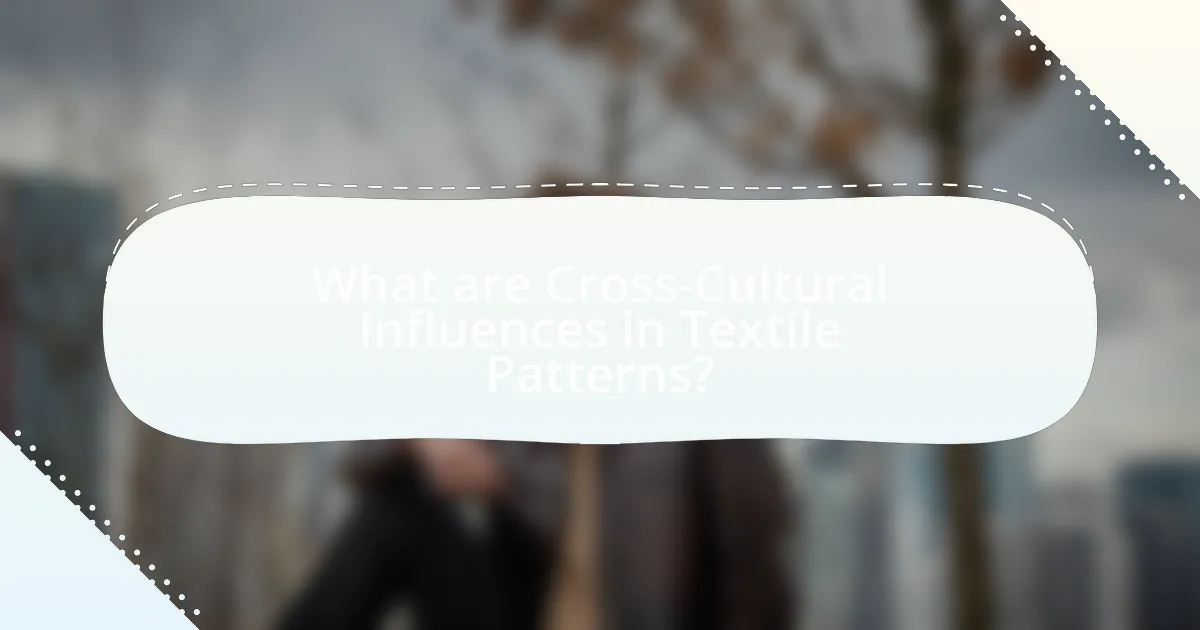Cross-cultural influences in textile patterns encompass the sharing, adaptation, and integration of design elements from various cultures into textile arts, resulting in hybrid styles that reflect a blend of traditions. The article explores how different cultures contribute unique motifs, techniques, and symbolism to textile designs, highlighting the significance of historical events and cultural contexts in shaping these patterns. It also examines the role of textile patterns in fashion design, their impact on cultural identity, and consumer perception, while addressing the challenges of cultural appropriation and the importance of ethical considerations. Additionally, the article discusses future trends in cross-cultural textile patterns, emphasizing the intersection of globalization, sustainability, and technological advancements in the fashion industry.

What are Cross-Cultural Influences in Textile Patterns?
Cross-cultural influences in textile patterns refer to the ways in which different cultures share, adapt, and integrate design elements into their textile arts. These influences can be seen in the use of motifs, colors, and techniques that originate from various cultural backgrounds, often resulting in hybrid styles that reflect a blend of traditions. For instance, the incorporation of African tribal patterns into Western fashion illustrates how cultural exchange can lead to innovative designs that resonate with diverse audiences. Historical trade routes, such as the Silk Road, facilitated the exchange of textiles and patterns, allowing for the diffusion of artistic ideas across continents. This blending of cultural aesthetics not only enriches the textile industry but also fosters a greater appreciation for global artistry in fashion design.
How do different cultures contribute to textile patterns?
Different cultures contribute to textile patterns through unique motifs, techniques, and symbolism that reflect their histories and values. For instance, Indigenous American textiles often feature geometric designs that represent nature and spirituality, while Japanese textiles utilize intricate dyeing techniques like shibori, showcasing a deep appreciation for aesthetics and craftsmanship. Additionally, African textiles are known for vibrant colors and patterns that convey social status and cultural identity. These diverse contributions not only enrich the global textile landscape but also influence contemporary fashion design by inspiring designers to incorporate traditional elements into modern garments, thereby fostering a dialogue between cultures.
What specific elements of culture influence textile designs?
Specific elements of culture that influence textile designs include symbolism, traditional motifs, color significance, and regional materials. Symbolism in textiles often reflects cultural beliefs and values, such as the use of specific patterns that represent fertility or protection in various societies. Traditional motifs, like paisley in Persian culture or ikat in Southeast Asia, are integral to regional identities and are frequently incorporated into modern designs. Color significance varies across cultures; for instance, red symbolizes luck in Chinese culture, while it may represent mourning in others. Additionally, the availability of regional materials, such as silk in China or wool in Scotland, shapes the texture and style of textiles, directly impacting design choices. These cultural elements are essential in creating textiles that resonate with specific audiences and convey deeper meanings.
How do historical events shape textile patterns across cultures?
Historical events significantly shape textile patterns across cultures by influencing the materials, techniques, and motifs used in fabric design. For instance, the Silk Road facilitated the exchange of textiles and patterns between East and West, leading to the incorporation of Asian motifs in European fabrics during the Renaissance. Additionally, colonialism introduced new materials, such as cotton and indigo, which transformed local textile traditions in colonized regions, as seen in the adaptation of Indian block printing techniques in British textile manufacturing. These historical interactions not only altered the aesthetic qualities of textiles but also reflected cultural exchanges and socio-political dynamics, demonstrating how history directly impacts the evolution of textile patterns across different cultures.
Why are textile patterns significant in fashion design?
Textile patterns are significant in fashion design because they convey cultural identity, aesthetic appeal, and emotional resonance. Patterns often reflect the heritage and traditions of different cultures, influencing the visual language of fashion. For instance, the use of paisley patterns in Western fashion can be traced back to Persian textiles, showcasing how cross-cultural exchanges shape design elements. Additionally, patterns can evoke specific feelings or themes, such as floral designs symbolizing femininity or geometric patterns representing modernity. This interplay between culture and design not only enhances the uniqueness of fashion items but also fosters a deeper connection between the wearer and the garment, making textile patterns a crucial aspect of fashion design.
What role do textile patterns play in cultural identity?
Textile patterns serve as a vital expression of cultural identity by reflecting the history, beliefs, and values of a community. These patterns often incorporate symbols and motifs that are significant to specific cultures, such as the intricate designs found in traditional African textiles, which can convey stories or represent social status. For instance, the use of specific colors and patterns in Indigenous textiles often signifies tribal affiliation and cultural heritage. Additionally, research indicates that textile patterns can influence social cohesion and community identity, as seen in the way certain patterns are used in ceremonial garments to reinforce cultural narratives.
How do textile patterns affect consumer perception in fashion?
Textile patterns significantly influence consumer perception in fashion by evoking emotional responses and cultural associations. For instance, bold geometric patterns may be perceived as modern and innovative, while floral designs often evoke feelings of femininity and romance. Research indicates that consumers often associate specific patterns with particular lifestyles or identities, impacting their purchasing decisions. A study published in the Journal of Fashion Marketing and Management found that consumers’ preferences for certain patterns are closely linked to their cultural backgrounds and personal experiences, demonstrating that textile patterns can serve as a form of non-verbal communication that conveys social status, cultural identity, and personal style.

How do Cross-Cultural Influences Impact Fashion Design?
Cross-cultural influences significantly impact fashion design by introducing diverse aesthetics, techniques, and cultural narratives into the creative process. Designers often draw inspiration from various cultures, leading to the incorporation of unique textile patterns, colors, and silhouettes that reflect a blend of traditions. For instance, the use of African prints in Western fashion has gained popularity, showcasing how traditional motifs can be reinterpreted in contemporary designs. This blending not only enriches the fashion landscape but also fosters cultural appreciation and dialogue, as seen in collections by designers like Stella Jean, who merges Italian tailoring with Caribbean influences. Such cross-cultural exchanges enhance innovation in fashion, making it more inclusive and globally resonant.
What are the key ways that textile patterns influence fashion trends?
Textile patterns significantly influence fashion trends through their ability to evoke cultural narratives, inspire seasonal themes, and drive consumer preferences. Cultural narratives embedded in textile patterns, such as traditional motifs from various regions, can shape fashion collections by reflecting heritage and identity, as seen in the resurgence of African prints in Western fashion. Seasonal themes are also impacted, with floral patterns often dominating spring collections, aligning with nature’s bloom, while darker, geometric patterns are prevalent in fall and winter lines. Additionally, consumer preferences are swayed by the visual appeal and emotional resonance of textile patterns, leading brands to adopt trending designs that resonate with target demographics, evidenced by the popularity of tie-dye patterns during the pandemic, which reflected a desire for comfort and nostalgia.
How do designers incorporate diverse textile patterns into their collections?
Designers incorporate diverse textile patterns into their collections by researching and integrating cultural motifs, techniques, and color palettes from various global traditions. This practice not only enriches their designs but also reflects a growing trend towards inclusivity and representation in fashion. For instance, designers like Stella Jean and Etro have successfully blended African prints and Asian textiles into their collections, showcasing the beauty of cross-cultural exchange. This approach is supported by the increasing consumer demand for authenticity and diversity in fashion, as evidenced by a 2021 McKinsey report indicating that 67% of consumers prefer brands that reflect their values, including cultural appreciation.
What are the challenges faced by designers when blending cultural patterns?
Designers face several challenges when blending cultural patterns, primarily including cultural appropriation, misrepresentation, and the difficulty of achieving aesthetic harmony. Cultural appropriation occurs when designers use elements from a culture without understanding or respecting their significance, leading to backlash from the originating communities. Misrepresentation arises when cultural symbols are used inaccurately, which can perpetuate stereotypes or dilute the original meaning. Achieving aesthetic harmony is challenging as designers must navigate the complexities of combining diverse visual languages while maintaining coherence in their designs. These challenges highlight the need for sensitivity and thorough research in cross-cultural design practices.
Why is it important for designers to understand cultural contexts?
Understanding cultural contexts is crucial for designers because it informs their creative decisions and enhances the relevance of their work. Designers who grasp cultural nuances can create designs that resonate with specific audiences, leading to greater acceptance and appreciation of their products. For instance, research indicates that culturally informed designs can increase consumer engagement by up to 30%, as they reflect the values and aesthetics of the target demographic. This understanding helps avoid cultural appropriation and fosters respect for diverse traditions, ultimately contributing to a more inclusive and innovative design landscape.
How can cultural appropriation affect fashion brands?
Cultural appropriation can significantly affect fashion brands by leading to public backlash, loss of consumer trust, and potential financial repercussions. When brands adopt elements from marginalized cultures without proper acknowledgment or respect, they risk being accused of exploitation, which can result in negative media coverage and social media outrage. For instance, brands like Urban Outfitters and Dior have faced criticism for using Native American motifs and traditional designs without permission, leading to calls for boycotts and damaging their reputations. This backlash can ultimately affect sales and brand loyalty, as consumers increasingly prefer brands that demonstrate cultural sensitivity and ethical practices.
What are the ethical considerations in using cross-cultural textile patterns?
The ethical considerations in using cross-cultural textile patterns include cultural appropriation, respect for intellectual property, and the potential for misrepresentation. Cultural appropriation occurs when elements of one culture are used by another, often without permission or understanding, which can lead to exploitation and disrespect. Respect for intellectual property is crucial, as many textile patterns are tied to specific cultural identities and histories, and using them without acknowledgment can undermine their significance. Misrepresentation can arise when patterns are used in ways that distort their original meanings or contexts, leading to a lack of authenticity and potentially offending the cultures from which they originate. These considerations highlight the importance of engaging with cultural patterns thoughtfully and respectfully, ensuring that the voices and rights of the originating cultures are honored.

What are the Future Trends in Cross-Cultural Textile Patterns and Fashion Design?
Future trends in cross-cultural textile patterns and fashion design include increased globalization, sustainability, and technological integration. Globalization facilitates the blending of diverse cultural motifs, leading to innovative designs that reflect a fusion of traditions. Sustainability is becoming paramount, with designers increasingly sourcing materials ethically and incorporating eco-friendly practices, as evidenced by the rise of brands prioritizing sustainable textiles. Technological advancements, such as digital printing and 3D design, enable the creation of intricate patterns that can be customized to reflect various cultural influences. These trends are supported by market research indicating a growing consumer demand for unique, culturally inspired fashion that aligns with ethical values.
How are globalization and technology shaping textile patterns?
Globalization and technology are significantly shaping textile patterns by facilitating cross-cultural exchanges and enabling advanced production techniques. Globalization allows designers to access diverse cultural motifs and traditional patterns from around the world, leading to a fusion of styles that reflects a global aesthetic. For instance, the rise of fast fashion brands has increased the demand for varied textile designs, prompting the incorporation of ethnic patterns into mainstream fashion.
Technology enhances this process through digital printing and design software, which allows for rapid prototyping and customization of textile patterns. According to a report by the Textile World, digital textile printing has grown by over 30% annually, enabling designers to experiment with intricate designs that were previously difficult to produce. This combination of globalization and technology not only diversifies textile patterns but also accelerates their evolution in the fashion industry.
What innovations are emerging in textile design influenced by cross-cultural elements?
Innovations in textile design influenced by cross-cultural elements include the integration of traditional motifs from various cultures into contemporary fabrics, the use of sustainable materials inspired by indigenous practices, and the application of advanced digital printing techniques that allow for intricate designs reflecting diverse cultural heritages. For instance, designers are increasingly adopting patterns from African, Asian, and Indigenous American textiles, blending them with modern aesthetics to create unique collections. This approach not only celebrates cultural diversity but also promotes ethical fashion by sourcing materials sustainably, as seen in brands that collaborate with artisans worldwide. The rise of digital textile printing technology further enables designers to reproduce complex patterns with precision, making it easier to incorporate cross-cultural designs into mainstream fashion.
How do sustainability practices intersect with cross-cultural textile influences?
Sustainability practices intersect with cross-cultural textile influences by promoting the use of traditional techniques and materials that minimize environmental impact. For instance, many cultures utilize natural dyes and locally sourced fibers, which align with sustainable practices by reducing carbon footprints and chemical usage. The revival of indigenous textile methods, such as weaving and dyeing, not only preserves cultural heritage but also encourages eco-friendly production methods. Research indicates that brands adopting these practices, like Patagonia and Eileen Fisher, have successfully integrated cultural textile influences while prioritizing sustainability, demonstrating a viable model for the fashion industry.
What practical tips can designers follow when incorporating cross-cultural influences?
Designers can effectively incorporate cross-cultural influences by conducting thorough research on the cultural significance of patterns and symbols. Understanding the historical context and meanings behind specific designs ensures respectful and accurate representation. For instance, the use of traditional motifs from indigenous cultures should be approached with sensitivity to avoid cultural appropriation. Additionally, collaborating with local artisans can provide authentic insights and techniques, enhancing the design process. A study by the Fashion Institute of Technology highlights that designers who engage with cultural narratives create more meaningful and resonant collections, demonstrating the importance of cultural context in fashion design.

Leave a Reply